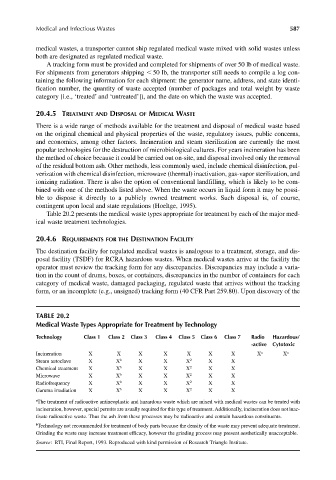Page 616 - Materials Chemistry, Second Edition
P. 616
CAT3525_C20.qxd 1/27/2005 12:54 PM Page 587
Medical and Infectious Wastes 587
medical wastes, a transporter cannot ship regulated medical waste mixed with solid wastes unless
both are designated as regulated medical waste.
A tracking form must be provided and completed for shipments of over 50 lb of medical waste.
For shipments from generators shipping 50 lb, the transporter still needs to compile a log con-
taining the following information for each shipment: the generator name, address, and state identi-
fication number, the quantity of waste accepted (number of packages and total weight by waste
category [i.e., ‘treated’ and ‘untreated’]), and the date on which the waste was accepted.
20.4.5 TREATMENT AND DISPOSAL OF MEDICAL WASTE
There is a wide range of methods available for the treatment and disposal of medical waste based
on the original chemical and physical properties of the waste, regulatory issues, public concerns,
and economics, among other factors. Incineration and steam sterilization are currently the most
popular technologies for the destruction of microbiological cultures. For years incineration has been
the method of choice because it could be carried out on-site, and disposal involved only the removal
of the residual bottom ash. Other methods, less commonly used, include chemical disinfection, pul-
verization with chemical disinfection, microwave (thermal) inactivation, gas-vapor sterilization, and
ionizing radiation. There is also the option of conventional landfilling, which is likely to be com-
bined with one of the methods listed above. When the waste occurs in liquid form it may be possi-
ble to dispose it directly to a publicly owned treatment works. Such disposal is, of course,
contingent upon local and state regulations (Hoeltge, 1995).
Table 20.2 presents the medical waste types appropriate for treatment by each of the major med-
ical waste treatment technologies.
20.4.6 REQUIREMENTS FOR THE DESTINATION FACILITY
The destination facility for regulated medical wastes is analogous to a treatment, storage, and dis-
posal facility (TSDF) for RCRA hazardous wastes. When medical wastes arrive at the facility the
operator must review the tracking form for any discrepancies. Discrepancies may include a varia-
tion in the count of drums, boxes, or containers, discrepancies in the number of containers for each
category of medical waste, damaged packaging, regulated waste that arrives without the tracking
form, or an incomplete (e.g., unsigned) tracking form (40 CFR Part 259.80). Upon discovery of the
TABLE 20.2
Medical Waste Types Appropriate for Treatment by Technology
Technology Class 1 Class 2 Class 3 Class 4 Class 5 Class 6 Class 7 Radio Hazardous/
-active Cytotoxic
Incineration X X X X X X X X a X a
Steam autoclave X X b X X X 2 X X
Chemical treatment X X b X X X 2 X X
Microwave X X b X X X 2 X X
Radiofrequency X X b X X X 2 X X
Gamma irradiation X X b X X X 2 X X
a
The treatment of radioactive antineoplastic and hazardous waste which are mixed with medical wastes can be treated with
incineration, however, special permits are usually required for this type of treatment. Additionally, incineration does not inac-
tivate radioactive waste. Thus the ash from these processes may be radioactive and contain hazardous constituents.
b
Technology not recommended for treatment of body parts because the density of the waste may prevent adequate treatment.
Grinding the waste may increase treatment efficacy, however the grinding process may present aesthetically unacceptable.
Source: RTI, Final Report, 1993. Reproduced with kind permission of Research Triangle Institute.

